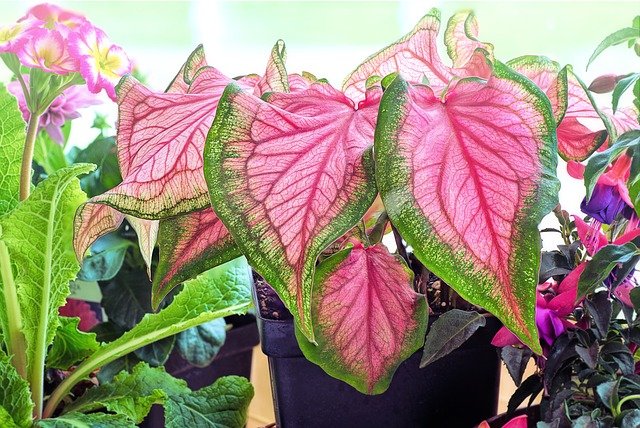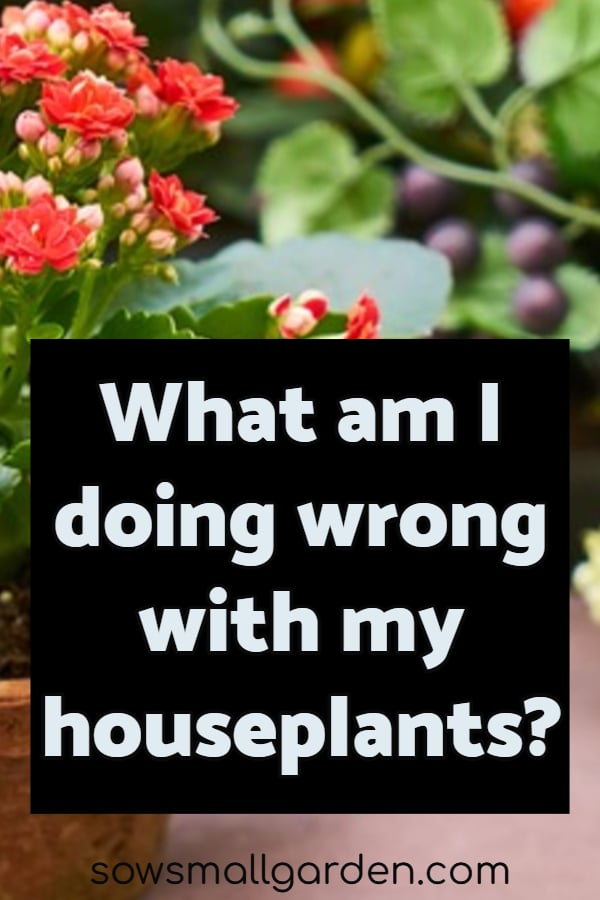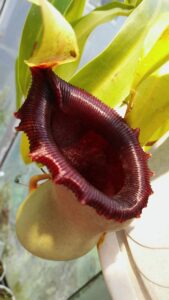Last Updated on October 1, 2023
Can’t keep your houseplant alive?
Constantly asking yourself, ”Why are my indoor plants not doing well? What am I doing wrong with my house plants?”
Let’s figure out why your houseplants aren’t happy and how to fix it.

*This post contains affiliate links. If you choose to purchase any of the products I have recommended, I may receive a commission at no cost to you.
How do I know if I have houseplant problems?
Indoor plants can give pleasure year-round without causing much trouble or taking much time. But sometimes our house plants become unhappy, which is easy to spot.
Signs of unhealthy house plants:
- yellowing and falling leaves
- dry brown leaf tips, spots and patches
- slow stunted growth
- inability to produce flowers on houseplants that should flower (for example, African violets, or geranium)
- leggy stems, or mushy stems
- bud drop
- crusty white soil
- white or yellow-mold like growth on the top of the soil
- pest infestation.
All the above signs signal that your indoor plant is unhealthy, but when the plant is severely wilted and droopy, it’s dying and screams for help, that’s SOS in plant language.
Why are my plants unhappy?
Your houseplant’s unhealthiness can be caused by many factors,
6 main causes of houseplant problems are:
- water (too much or not enough),
- light (too much or lack of),
- too much or not enough nutrients (over-fertilizing can cause serious problems
- planter is too small (not enough space to grow, so plant becomes root bound)
- poor soil drainage
- pests
How do you know if a plant is being over or under-watered?
As we discussed before, when the plant is severely under or overwatered, it will look wilted, the leaves will be droopy.
If you water your houseplant too little, the plant’s leaves will feel dry to the touch, while too much water will result in soft and limp yellowish leaves.
To be sure that the plant is watered properly, you can stick your finger in the soil – the soil should feel slightly moist but not soggy.
If watering plants seems like a chore for you, try to use watering globes that will provide continuous water supply and maintain adequate moisture. Just don’t forget to refill the globe with water.
I know that there are also self-watering pots for indoor plants on the market, but for some reason, they never worked well for me.
Another thing to remember is that indoor plants, as well as outdoor plants, go dormant in winter time and require very little watering. I water most of my indoor plants in winter just once a week, succulents – once in 2-3 weeks.
Read related: Self Watering Bulbs: The Ultimate Guide
How do you know if your plant is getting too much or not enough light?
The simplest way to know that your plant is not getting enough light is to look if it’s leaning toward the light. If it’s leaning – there is not enough light for this plant. To solve the problem, find a brighter spot in your house for your houseplant or use an artificial light specially made for indoor plants.
If a plant has too much sunshine, the leaves might become scorched by sun rays and have brown tips and patches. Leaves can also curl, droop, or shed.
What should you try if your plant has droopy leaves?
The reason for droopy leaves can be :
- lack of or too much water,
- too much direct sunshine,
- being under direct hot or cold moving air,
- too much fertilizer,
- plant disease or pests.
First, check if the soil in the pot has dried out. If so – water your plant.
If the soil is too soggy, the leaves of the plant also can droop. To avoid such situations be sure that the plant pot has a drainage hole and the plant is growing in a potting mix that ensures good drainage.
If you are sure that watering is not the reason for droopy leaves, take a look where your plant stands. Is it under an air register? Does it get too much direct sunshine (especially if it’s placed under a window in summertime)? If so – move your plant.
Also look on the underside of the leaves to see if there are aphids sucking the moisture from your plant. If you see an aphid infestation, you can try washing them off by taking your plant, turning it upside down and dipping it into a bucket of clean water.
Alternatively, you can spray leaves, especially undersides, with homemade or safe commercial insecticidal soap (for simple insecticidal soap recipe check out tip #10 in my article How to keep bugs from eating plants.)
How do you fix yellow and brown leaves on plants?
If your plant leaves are turning brown, it can be from lack of moisture in the air, especially in winter time. Running a humidifier in the room can fix this problem.
If you have a water softener and you water your plants with softened water, eventually salt will build up in the soil which can result in brown leaf tips. In order to avoid the problem, use bottled spring water to water your plants.
“Shallow watering” – when you just lightly moisten the top of soil and water doesn’t have a chance to get to the roots – can also cause brown crumbly leaf tips, or dry falling yellow leaves.
Actually, under or overwatering is a common cause of yellow indoor plant leaves.
How can I find out what’s wrong with my plant?
Pennsylvania State Extension has an excellent guide to help you troubleshoot and solve your house plant problems.
How to stabilize and revive your dying houseplant
First, I would try to trim damaged parts of the plant and then repot the plant.
After that, search the internet and learn about your plant’s light and water requirements and give it adequate care according to what it needs.
As for your future house plants, before making a buying decision think about whether or not your home can meet the chosen plant’s requirements for optimal growth.
To find your perfect indoor plant, check out my articles:
What should be kept in mind when caring for house plants?
Try not to overwater and overfertilize. Too much care is probably worse than too little.
I would also avoid replanting your houseplant in a pot with no drain hole because it’s a direct road to root rot.
The main thing to remember is that not all houseplants thrive in the same environment: some need lots of light or water, and others – are just the opposite. Learn what each indoor plant needs and give it proper care.
Related reading:
Final thoughts on common houseplants problems and how to solve them
Houseplants are the best way to add life and color into any home, but many people find it hard to keep them healthy. If you’ve struggled with keeping your houseplants alive, give these tips a try. You may find that they will help you to have thriving and healthy indoor plants!
If you found this article useful – be so kind to share with friends.

Pin for later reference!




